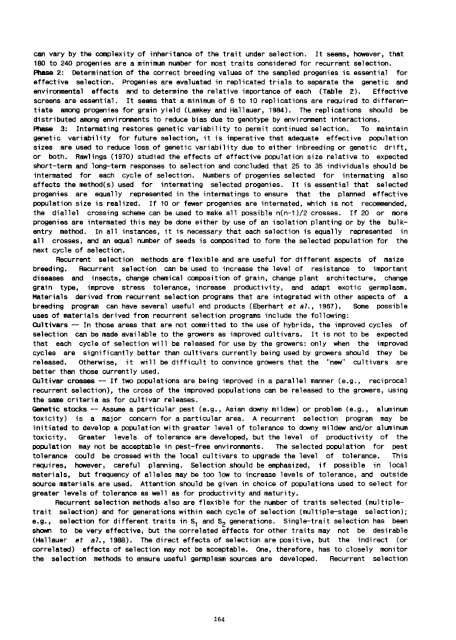Proceedings of the Fifth Asian Regional Maize Workshop - Search ...
Proceedings of the Fifth Asian Regional Maize Workshop - Search ...
Proceedings of the Fifth Asian Regional Maize Workshop - Search ...
You also want an ePaper? Increase the reach of your titles
YUMPU automatically turns print PDFs into web optimized ePapers that Google loves.
can vary by <strong>the</strong> complexity <strong>of</strong> inheritance <strong>of</strong> <strong>the</strong> trait under selection. It seems, however, that<br />
180 to 240 progenies are a minimum number for most traits considered for recurrent selection.<br />
Phase 2: Determination <strong>of</strong> <strong>the</strong> correct breeding values <strong>of</strong> <strong>the</strong> sampled progenies is essential for<br />
effective selection. Progenies are evaluated in replicated trials to separate <strong>the</strong> genetic and<br />
environmental effects and to determine <strong>the</strong> relative importance <strong>of</strong> each (Table 2). Effective<br />
screens are essential. It seems that a minimum <strong>of</strong> 6 to 10 replications are required to differentiate<br />
among progenies for grain yield (Lamkey and Hallauer, 1984). The replications should be<br />
distributed among environments to reduce bias due to genotype by environment interactions.<br />
Phase 3: Intermating restores genetic variability to permit continued selection. To maintain<br />
genetic variability for future selection, it is imperative that adequate effective population<br />
sizes are used to reduce loss <strong>of</strong> genetic variability due to ei<strong>the</strong>r inbreeding or genetic drift,<br />
or both. Rawlings (1970) studied <strong>the</strong> effects <strong>of</strong> effective population size relative to expected<br />
short-term and long-term responses to selection and concluded that 25 to 35 individuals should be<br />
intermated for each cycle <strong>of</strong> selection. Numbers <strong>of</strong> progenies selected for intermating also<br />
affects <strong>the</strong> methodes) used for intermating selected progenies. It is essential that selected<br />
progenies are equally represented in <strong>the</strong> intermatings to ensure that <strong>the</strong> planned effective<br />
population size is realized. If 10 or fewer progenies are intermated, which is not recommended,<br />
<strong>the</strong> dia11e1 crossing scheme can be used to make all possible n(n-1)/2 crosses. If 20 or more<br />
progenies are intermated this may be done ei<strong>the</strong>r by use <strong>of</strong> an isolation planting or by <strong>the</strong> bulkentry<br />
method. In all instances, it is necessary that each selection is equally represented in<br />
all crosses, and an equal number <strong>of</strong> seeds is composited to form <strong>the</strong> selected population for <strong>the</strong><br />
next cycle <strong>of</strong> selection.<br />
Recurrent selection methods are flexible and are useful for different aspects <strong>of</strong> maize<br />
breeding. Recurrent selection can be used to increase <strong>the</strong> level <strong>of</strong> resistance to important<br />
diseases and insects, change chemical composition <strong>of</strong> grain, change plant architecture, change<br />
grain type, improve stress tolerance, increase productivity, and adapt exotic germp1asm.<br />
Materials derived from recurrent selection programs that are integrated with o<strong>the</strong>r aspects <strong>of</strong> a<br />
breeding program can have several useful end products (Eberhart et aT., 1967). Some possible<br />
uses <strong>of</strong> materials derived from recurrent selection programs include <strong>the</strong> following:<br />
Cultivars -- In those areas that are not committed to <strong>the</strong> use <strong>of</strong> hybrids, <strong>the</strong> improved cycles <strong>of</strong><br />
selection can be made available to <strong>the</strong> growers as improved cultivars. It is not to be expected<br />
that each cycle <strong>of</strong> selection will be released for use by <strong>the</strong> growers: only when <strong>the</strong> improved<br />
cycles are significantly better than cultivars currently being used by growers should <strong>the</strong>y be<br />
released. O<strong>the</strong>rwise, it will be difficult to convince growers that <strong>the</strong> "new" cultivars are<br />
better than those currently used.<br />
Cultivar cnosses -- If two populations are being improved in a parallel manner (e.g., reciprocal<br />
recurrent selection), <strong>the</strong> cross <strong>of</strong> <strong>the</strong> improved populations can be released to <strong>the</strong> growers, using<br />
<strong>the</strong> same criteria as for cu1tivar releases.<br />
Genetic stocks -- Assume a particular pest (e.g., <strong>Asian</strong> downy mi 1dew) or problem (e.g., aluminum<br />
tOXicity) is a major concern for a particular area. A recurrent selection program may be<br />
initiated to develop a population with greater level <strong>of</strong> tolerance to downy mildew and/or aluminum<br />
toxicity. Greater levels <strong>of</strong> tolerance are developed, but <strong>the</strong> level <strong>of</strong> productivity <strong>of</strong> <strong>the</strong><br />
population may not be acceptable in pest-free environments. The selected population for pest<br />
tolerance could be crossed with <strong>the</strong> local cu1tivars to upgrade <strong>the</strong> level <strong>of</strong> tolerance. This<br />
requires, however, careful planning. selection should be emphasized, if possible in local<br />
materials, but frequency <strong>of</strong> alleles may be too low to increase levels <strong>of</strong> tolerance, and outside<br />
source materials are used. Attention should be given in choice <strong>of</strong> populations used to select for<br />
greater levels <strong>of</strong> tolerance as well as for prod~ctivity and maturity.<br />
Recurrent selection methods also are flexible for <strong>the</strong> number <strong>of</strong> traits selected (mu1tipletrait<br />
selection) and for generations within each cycle <strong>of</strong> selection (multiple-stage selection);<br />
e.g., selection for different traits in S1 and S2 generations. Single-trait selection has been<br />
shown to be very effective, but <strong>the</strong> correlated effects for o<strong>the</strong>r traits may not be desirable<br />
(Hallauer et aT., 1988). The direct effects <strong>of</strong> selection are positive, but <strong>the</strong> indirect (or<br />
correlated) effects <strong>of</strong> selection may not be acceptable. One, <strong>the</strong>refore, has to closely monitor<br />
<strong>the</strong> selection methods to ensure useful germplasm sources are developed. Recurrent selection<br />
164

















